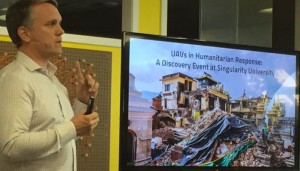































Okay,I admit, the headline is a bad pun. But, what isn't bad is the speed at which drone technology is being used to save livesbefore, duringandaftera devastating event. On April 11, I was invited to attend a Discovery Event at Singularity University at Moffett Field on Unmanned Aerial Vehicles (UAVs) in Humanitarian Response. I was invited because I work in the Cisco Corporate Social Responsibility group and we supported the event. But I really went because I love discovering the endless ways technology is positioned to improve the human condition exponentially, and share those stories with the world.
With our nonprofit partner InSTEDD (Innovative Support to Emergencies, Diseases and Disasters), we supported a 3-day workshop that gathered a diverse and savvy group of UAV experts already using drones for humanitarian relief. We asked them to go beyond their current thinking and envision what more can be done with this rapidly advancing technology. It's a known fact that when technologists are gathered to solve a problem, and unencumbered by daily obligations, amazing things happen. When I walked in, the excitement and enthusiasm in the room was palpable.
We have all seen the recent news on the earthquake that killed more than 480 people in Ecuador. In 2015, according to the UN Office for Disaster Risk Reduction, there were 346 reported disasters that affected 98.6 million people. A disaster takes many forms but most common are earthquakes, heat waves, landslides and floods. What we know is that these types of environmental disasters will continue to increase and have a rippling impact on lives, resources and the economy. What we don't know is when, where and how they will strike...at least not yet.
InSTEDD CEO Eduardo Jezierski spoke eloquently about the future possibilities of specialized drones. He said, "We need to get past the talk to begin to operationalize UAV use. You have to bring the right people together at the right time in order to scale and be ready for the next disaster." It is clear that as development costs go down, drones can be used for such activities as mountainous delivery of essential medical and bio-safe materials to remote communities, mapping of historical sites such as the World Heritage Organization sites to track erosion, or delivering sterile Tsetse flies in Ethiopia to prevent epidemics.
While local regulatory hurdles keep the barriers high for indiscriminate use, the ethical question of drones is not new. They provoke questions that have been debated in the humanitarian community for years. Evan Huddleson from HaloDrop, a company that provides trained drone response teams, reminded the audience that disasters are chaotic. He stated, "Sometimes global humanitarian groups find themselves going up against the local government agencies, but if you start off with the right intention you will end up in the right place to help people." But, media organizations and government officials who have a megaphone and a platform must improve their understanding of these new technologies and advance policies that will bring the right people together to promote their good use, so that during the chaos of a disaster, devastation is minimized and goodwill is advanced.
By the evening's end I had learned so much about unlocking the potential of drone technology. I was feeling a bit guilty about my derisive laughter when my son gave my husband his own little backyard drone. I learned not only about the good this type of technology can do, but the importance for all of us to be educated beyond sensationalized headlines on the wariness of technology innovations.
the wariness of technology innovations.
John Thompson from Skycatch, a for-profit drone data software company, spoke about how his company is changing perceptions about use and abuse of drones. Skycatch@School is their new initiative that sends pilots and engineers into schools to teach students about drones, engineering and aviation. Imagine the thrill of sparking a child's imagination to be a drone pilot for good.
There are many times I am frustrated by the slow pace of new technology adoption and disappointed when I read yet another article on the wonders of a technology designed to solve a non-existent problem. But then I attend an event like this where the last question of the evening came from a government official in the Netherlands, where over 20% of the country is already underwater. He stood up and said, "We need someone, right now, to map the erosion of our levees. The sooner we do this the sooner we can save lives." I am then struck once again by the power of technology combined with the ingenuity of the human mind to solve global problems.
 Tags quentes :
Corporate Social Responsibility (CSR)
disaster relief
UAV
Tags quentes :
Corporate Social Responsibility (CSR)
disaster relief
UAV